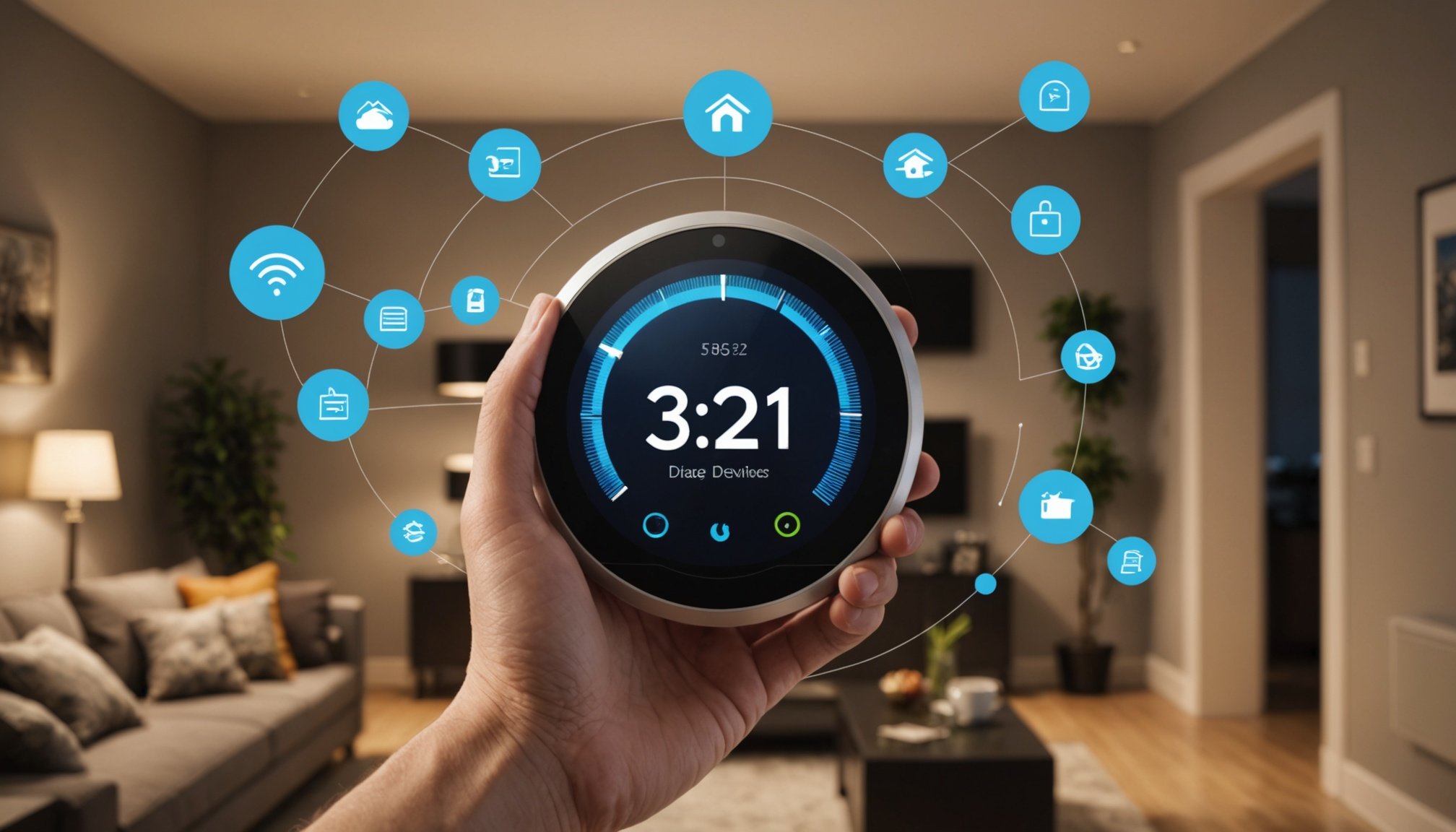Overview of Revolutionary Smart Home Devices
Smart home technology is transforming the way we manage our households, offering greater energy efficiency and convenience. These innovative devices automate routine tasks and optimize resource consumption, reducing environmental impact. The essence of smart home devices lies in their ability to connect various household appliances via the internet, enabling seamless control and monitoring through smartphones or voice-activated assistants.
Recent advancements in smart home technology include devices like smart thermostats, lighting systems, and energy monitors. These tools contribute significantly to energy savings by allowing users to adjust settings remotely and schedule operations based on usage patterns. For instance, smart thermostats automatically regulate heating and cooling, ensuring comfort while minimizing energy usage.
Also read : Harnessing AI to Revolutionize Predictive Analytics in UK Healthcare for Superior Outcomes
Investing in energy-saving smart home devices offers several benefits. Primarily, they lead to reduced utility bills through efficient management of energy resources. Moreover, they enhance the quality of life by offering convenience and improved security. As homes become more intelligent, the integration of smart devices contributes to a sustainable lifestyle, promoting both user satisfaction and ecological responsibility. This trend underscores the growing importance of smart home technology in future household management.
Key Features of Energy-Saving Smart Home Devices
Harnessing energy-saving features in smart home devices can substantially enhance efficiency and reduce costs. These devices blend smart technology with automation, transforming how homes consume energy. Here’s a detailed look at the benefits and mechanisms.
In parallel : Unlock your space: loft conversion benefits in wandsworth
Smart Thermostats
Effect on Heating and Cooling Efficiency
Smart thermostats adjust temperatures according to your schedule, significantly increasing heating and cooling efficiency. They learn from your habits to optimize settings.
Cost Savings through Automation
With automation, smart thermostats help lower energy bills by reducing unnecessary use. Users can achieve significant savings almost effortlessly.
User-Friendly Interfaces and Remote Access
These devices come with intuitive interfaces and remote control capabilities, allowing adjustments on-the-go via smartphones or other smart devices.
Smart Lighting Systems
Energy-Saving Benefits of LED Technology
Smart lighting uses energy-efficient LED technology, reducing electricity consumption while providing ample illumination.
Smart Control and Scheduling Features
Through programmable controls and scheduling, users can minimise energy waste by turning off lights when not needed.
Integration with Other Smart Home Systems
Smart lights seamlessly integrate into existing home systems, enabling more comprehensive energy management. They’re compatible with smart assistants for voice control.
Energy Monitoring Devices
Real-Time Energy Usage Tracking
Energy monitors provide real-time tracking, allowing households to identify consumption patterns.
Identifying Energy Waste Patterns
By analysing usage data, these devices help pinpoint areas of excess consumption.
Setting Goals for Energy Reduction
Users can set targets for energy savings, observing progress through detailed reports.
Comparative Analysis of Top Smart Home Devices
Navigating the world of smart home technology can be complex with so many innovative devices available. Performing product comparisons based on user reviews and feature analysis guarantees an informed choice in building an efficient, tech-savvy home.
Thermostats: Nest vs. Ecobee
Nest and Ecobee, both famous in smart thermostats, offer unique qualities. Nest boasts a user-friendly interface with a learning algorithm that personalises settings based on user habits. Meanwhile, Ecobee presents superior cost savings by involving room sensors that tune temperatures depending on presence, further optimising efficiency.
Smart Lighting: Philips Hue vs. LIFX
Regarding smart lighting, Philips Hue and LIFX distinguish themselves with different strengths. Philips Hue shines with its seamless integration and broad compatibility across smart systems. LIFX stands apart in the realm of energy efficiency with its simple setup and vibrant colour options, providing personalisation without hefty installation costs.
Monitoring Devices: Sense vs. Neurio
Sense and Neurio are renowned for their keen energy monitoring capabilities. Sense uses machine learning for thorough household energy tracking and detail-oriented insights. Meanwhile, Neurio presents critical energy consumption insights paired with long-term benefits by offering users the ability to form solid energy-saving strategies, increasing home efficiency effectively.
User Testimonials and Real-Life Applications
Smart home technology, combined with energy-saving features, is transforming households’ efficiency worldwide. User experiences reveal the tangible benefits, particularly in reducing energy consumption. For instance, Jane H., a resident of London, noticed a significant decrease in her electricity bill, which fell by 20% after installing smart lighting systems. The devices automatically dimmed or turned off when rooms were unoccupied, enhancing energy efficiency.
Practical applications further emphasize these benefits. Sam and Alex P., from New York, detailed their transition to an entirely smart home environment, focusing on energy savings. Their integration of smart thermostats and energy monitors facilitated precise energy management, tailoring heating and cooling to their lifestyle. Consequently, they reported a 25% reduction in overall energy usage within six months.
Testimonials also highlight considerable changes in utility bills post-implementation of innovative devices. Many users noted how such technology streamlined their energy consumption patterns. These real-life applications underscore the profound impact of smart home devices in fostering not only financial savings but also sustainable living practices, echoing a broader trend toward reducing ecological footprints in day-to-day activities.
Installation and Setup Tips
Smart home technology has made setting up innovative devices accessible, whether opting for a DIY or professional approach. Here, we explore important aspects of installation and setup, ensuring you achieve optimal energy efficiency.
General Installation Tips
Deciding between professional and DIY installation often hinges on complexity and personal skill level. Professionals can ensure safe and efficient setup, particularly for systems needing intricate wiring or connectivity, like smart thermostats or comprehensive home networks. However, enthusiasts frequently find satisfaction in DIY installation, potentially saving on costs. Essential tools for setup include screwdrivers, wire strippers, and smartphone apps for configuring devices.
Avoid common pitfalls by ensuring devices are compatible with your home’s existing systems. Missteps such as incorrect wiring or poor positioning can impair performance and reduce energy-saving capabilities. Always consult user manuals and guides.
Device-Specific Setup
Many manufacturers provide step-by-step instructions online or through apps, guiding users through the process, from unboxing to activation. Troubleshooting resources are invaluable for resolving issues like connectivity challenges or integration problems. Ensuring compatibility with your existing systems is crucial; verify requirements before purchase. Regular updates can enhance device performance and security, maintaining the longevity of your investment.
Future Trends in Smart Home Energy Efficiency
As emerging technologies continue to evolve, the realm of smart home innovations is undergoing rapid transformation, focusing on energy solutions and sustainability. A critical prediction is the integration of AI and machine learning into energy management systems. These intelligent technologies can analyse user behaviour to make real-time adjustments, optimising energy use without sacrificing comfort. For example, appliances could learn from daily routines, reducing energy consumption automatically.
In future, smart innovations will expand to encompass more intricate energy-saving measures, such as smart grids. These grids would enable better distribution of energy, accommodating renewable sources. This shift could significantly affect global energy consumption trends, making homes not just consumers but active participants in energy management.
Developers are keen on creating systems that further lessen the ecological footprint of households. This brings us to the potential rise of smart devices acting as both climate and cost controllers, managing energy in a way that benefits both users and the environment. Such technology holds promise for a future where energy efficiency is seamlessly woven into the fabric of daily life, fostering environmental consciousness alongside technical advancement.



